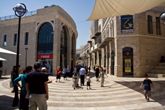×


We have detected your country as:
Please click here to go to the USA website or select another country from the dropdown list.
Mamilla
 Mamilla is a 121-dunam (30-acre) area outside Jaffa Gate and the walls of the Old City. The first plan to renew the area was approved in 1967 and has become one of the longest and most costly development plans in the city’s history (US $400 million). The project includes five historic buildings, a 207-room hotel, 50 luxury condos (ranging from US $1.1 to a $13 million penthouse), parking for 1,600 cars and 60 buses, and a US $150 million, two-level outdoor pedestrian mall with 140 upper-end businesses such as Rolex, H. Stern, and Polo Ralph Lauren
Mamilla is a 121-dunam (30-acre) area outside Jaffa Gate and the walls of the Old City. The first plan to renew the area was approved in 1967 and has become one of the longest and most costly development plans in the city’s history (US $400 million). The project includes five historic buildings, a 207-room hotel, 50 luxury condos (ranging from US $1.1 to a $13 million penthouse), parking for 1,600 cars and 60 buses, and a US $150 million, two-level outdoor pedestrian mall with 140 upper-end businesses such as Rolex, H. Stern, and Polo Ralph Lauren
In the first century, King Herod built a reservoir here, and until modern times, there was little else there but a few olive trees. In the late 19th century, it was one of the earliest neighborhoods constructed outside the Old City walls and became a Jewish–Arab business district. It became a combat zone in 1948, and until 1967, it was on the armistice line between Israel and the Jordanian-held sector of the city, falling into much disrepair. After Israel gained Jerusalem in the 1967 war, plans were made for the development of the area. Eventually, David’s Village, luxury apartments across from Jaffa Gate, and the plush 384-suite David’s Citadel Hotel, which hosts most international government officials, were completed.
The Light Rail
Jerusalem, being an ancient city, has always struggled in adjusting to modern-day traffic. The new light rail is the city’s solution, though not everyone approves of it—leastwise the city’s current mayor, Nir Barkat, who has fiercely opposed it since his election last year and has proposed a sharp curtailment of its original plan. Approved on October 3, 2000, under Ehud Olmert’s term as mayor, it was to have eight lines with a total of 54 kilometers (33.5 miles) of track. Barkat wants only two lines. At US $400 million for only the first line of 15 kilometers (9 miles), maybe he will get his wish.
It was originally proposed to begin in 2005, but the work didn’t start until April 2006 and is now scheduled to begin operating sometime in September/October 2010. The first car was delivered in September 2007 from France, where it was built by Alstom.
The first line starts north of Jerusalem’s center and down Jaffa Road, which will give the city a very different, modern, clean look. Some decry that it will change the character of the city. In January, it was reported that the plan was to reduce the bus line from 180 buses to a mere 30. With a huge mess in the very center of the commercial area, it has been reported that 90% of its merchants have lost money, some up to 50%. In all, around 1,500 workers have lost their jobs, but those who survive will no doubt find the change quite profitable.
Other critics say it will increase pollution and noise. Because the northern part of the line goes through territory captured by Israel in 1967, some see it as a detriment to a two-state solution. However, for many it will cut travel time from 70-minutes to a mere 24.
The Chords Bridge
Also known as the Bridge of Strings—symbolic of David’s harp—it is the first finished piece of the light rail track, started in 2005 and inaugurated on June 25, 2008 as part of Israel’s 60th anniversary. The bottom graceful sweep is where the light rail will turn back on its roundtrip course. Above it rises a 40-storey mast with 66 steel cables attached, making it the tallest structure on Jerusalem’s skyline thus far. Beside the track is a glass-sided pedestrian walkway, which is already being used. Future plans include a dressed-up, tree-filled piazza beneath it.
World renowned Spanish architect Santiago Calatrava, builder of over 40 bridges, has said that though it’s similar in its cantilever design (when a beam is supported only on one end) to other bridges he’s built, its curves and angles make it unique. Commenting on its religious symbolism, he said, “The word 'religious' comes from the Latin, meaning 'creating a link.' A bridge makes a lot of sense in a city like Jerusalem.”
But many people don’t see it that way. Though they might agree it’s beautiful in design, one resident commented, “It does not have enough space around it for people to appreciate its artistic merit.” Others contend its ultra-modern look doesn’t fit with the look and feel of Jerusalem, and that it’s too costly and extravagant. (A simple concrete bridge would have cost US $15 million, while this one cost $70 million.) However, one reporter compared these complaints to those registered over Paris’s famous Eiffel Tower when it was built in 1887. Few wanted it either, and yet, today, it is a worldwide symbol of the city.
Will the city’s residents and tourists like the new look? In time…when all the debris is cleared and everyone starts enjoying the benefits. Meanwhile it’s appropriate to pray: “Peace be within your walls, prosperity within your palaces” (Ps. 122:7).
Photo Credit: Photos: Johan Schutte
Photo Credit:
All logos and trademarks in this site are property of their respective owner. All other materials are property of Bridges for Peace. Copyright © 2025.
Website Site Design by J-Town Internet Services Ltd. - Based in Jerusalem and Serving the World.